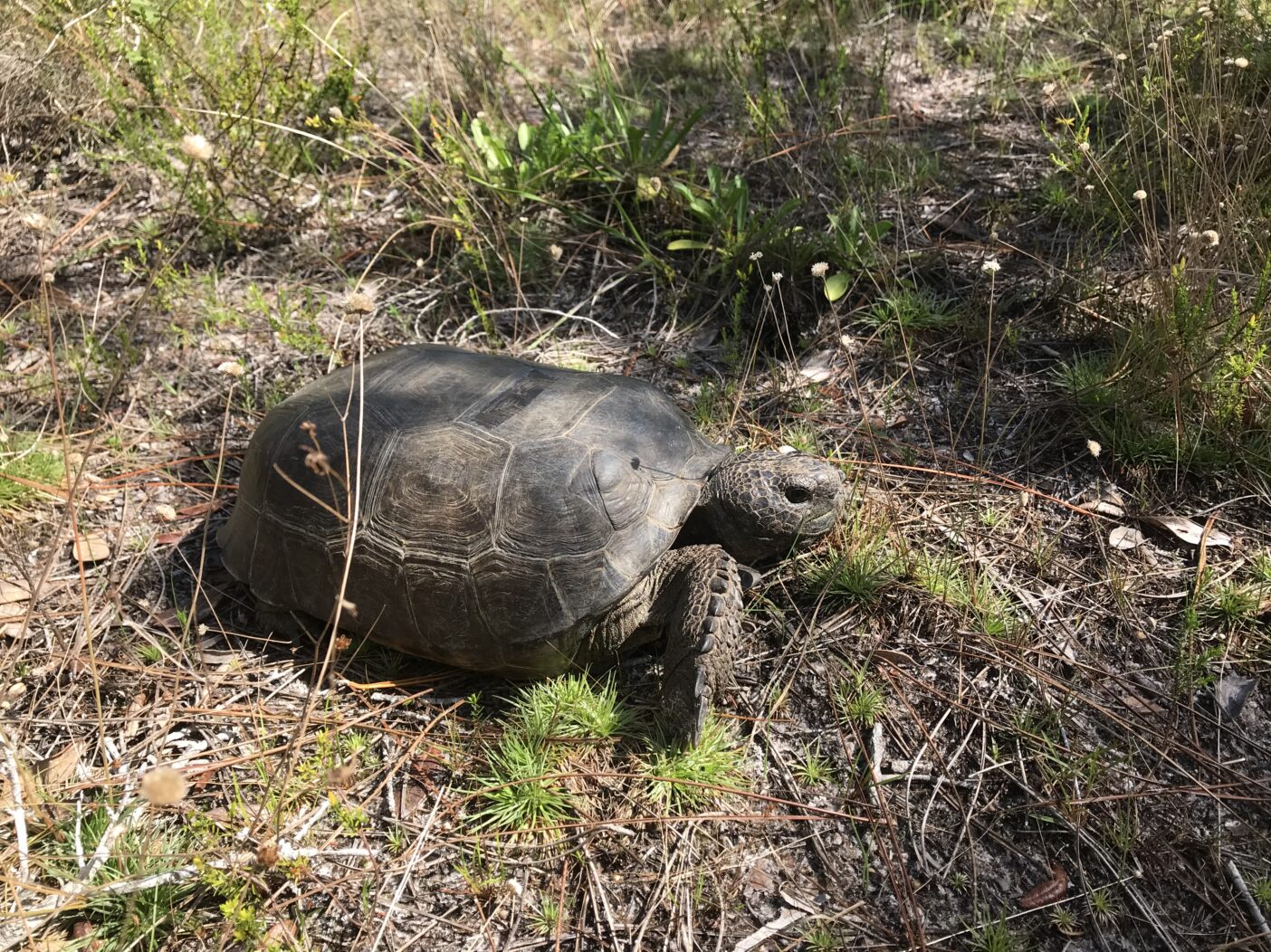

This blog supports this year’s Intertwined theme, which explores the connections in the natural world and the bond between people and plants.
When we think of home builders in Florida, the gopher tortoise (Gopherus polyphemus) may not be the first thing your mind envisions. But maybe it should be. Spring is the perfect time to recognize the contributions of this amazing reptile as we celebrate Gopher Tortoise Day on April 10. These ecosystem engineers have created burrows for the last 60 million years that support over 350 different species of animals.

The burrow of a gopher tortoise is surprisingly large compared to the tortoise’s modest size. According to the U.S. Fish and Wildlife Service, burrows can be as deep as 23 feet and as long as 52 feet. If you visit the Garden’s scrub habitat, you may see an area of excavated sandy debris. This is typically a sign of a nearby burrow. The opening of a burrow will be a half-moon shape that matches the size of the tortoise that makes its home inside. These underground chambers create a weather-stable residence where the gopher tortoise will spend up to 80% of its time.
This also makes it the perfect environment for housing the endangered eastern indigo snake (Drymarchon couperi), as well as the gopher frog (Lithobates capito) the gopher mouse (Podomys floridanus), and much more! These species have evolved to rely solely on the gopher tortoise burrow for their survival.
This is what makes the gopher tortoise a keystone species. Just as a keystone supports an arch in architecture, keystone species support other organisms in their environment. The removal of a keystone species can have a cascade effect leading to the demise of other living organisms in the ecosystem.

When gopher tortoises are not using their specialized, shovel-shaped front legs to excavate burrows, you might find them munching on the vegetation of their preferred upland habitats. Their dining preferences double as free garden labor because after foraging on native plants, the tortoises pass seeds back into the environment in their excrement. Through this method, the gopher tortoise shapes the flora of the ecosystem and distributes native plants like blanket flower (Gaillardia), purslane (Portulaca), verbena (Verbena officinalis), upland bent grass (Agrostis perennans), and thistle (Cirsium), among many more.
Unfortunately for the gopher tortoise, its pivotal role in the ecosystem wasn’t recognized until 1979 when Florida established it as a Species of Special Concern. During the Great Depression, gopher tortoises were plentiful enough that they provided a food source for people. People also raced gopher tortoises for amusement at fairs and sideshows. The population has declined by an estimated 80% over the last 100 years. Today, the state lists them as a “threatened” species.
A modern-day concern for gopher tortoises is land development. Their scrub habitat features dry elevated land that is ideal for land construction, thus posing a threat to the tortoises and their burrows. When land is slated for development, state law requires relocation of gopher tortoises to appropriate habitats. However, the process of removal can be stressful to tortoises that are already adapted to their landscape.

Gopher tortoises have made themselves quite at home in the Garden’s Preserve. During a Florida Fish and Wildlife survey in 2021, scientists counted 120 burrows and estimated a total Garden population of about 60 tortoises of varying ages. The Garden has a unique responsibility to maintain these areas. Part of that maintenance includes collecting seeds and storing them in our seedbank as well as sharing them with other organizations to help restore the imperiled habitat in which tortoises live. The Conservation Team also removes invasive exotic plants, which gives space for the native plants that the reptiles depend upon to flourish.
Next time you visit the Garden, stop by the information station, and ask an educator to tell you more about our Preserve. We offer guided and self-guided tours that explore this less-traversed part of the Garden. If you are fortunate, you might just spot one of these incredible creatures that humbly and inadvertently connect so many species.
A special thanks to Karen Relish and Kyle Possai for guiding me through the natural areas to experience the gopher tortoise habitat.

About the Author
Amanda Tower is the Office Coordinator for the Education and Visitor Experience Department. When not in the office, she enjoys cooking, kayaking, reading, and caring for her ever-growing collection of pets.


